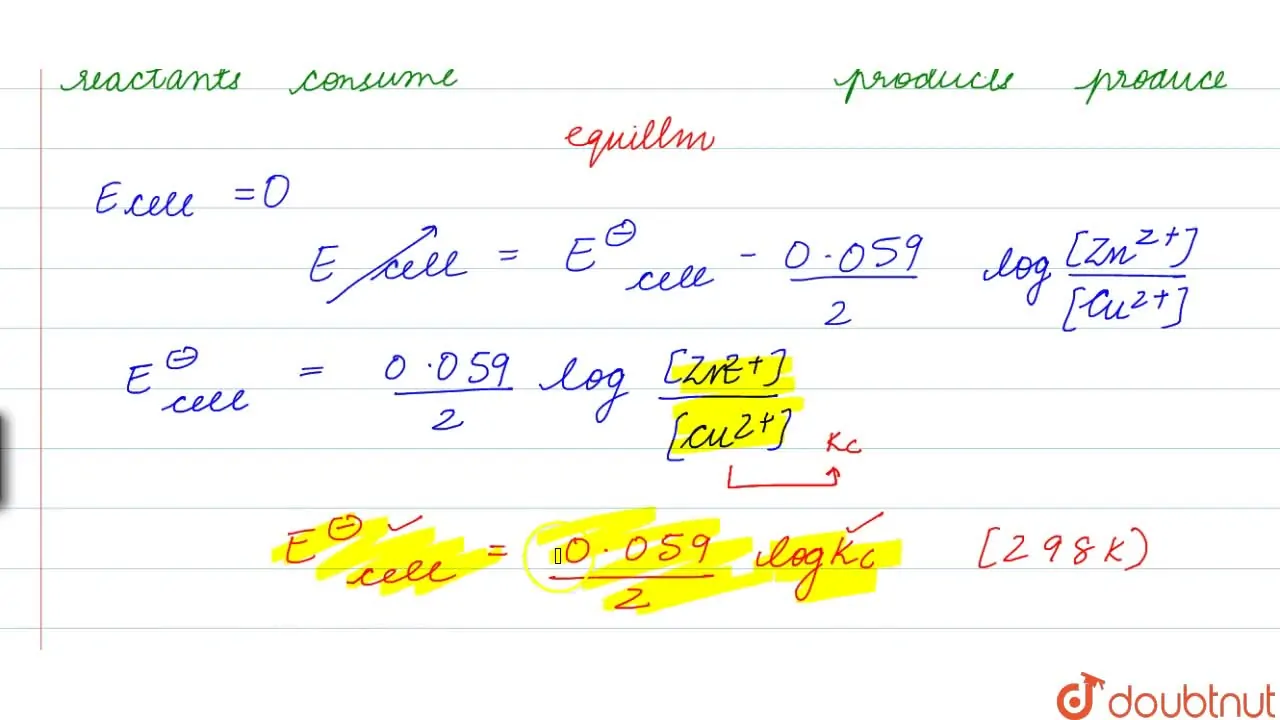Nernst Equation
Nernst Equation
What is Nernst Equation?
The Nernst equation describes a connection between the cell potential of an electrochemical cell, the standard cell potential, temperature, and the reaction quotient. Considerably under non-standard conditions, the cell potentials of electrochemical cells can be computed using the Nernst condition.
The Nernst condition is regularly used to ascertain the cell potential of an electrochemical cell at some random temperature, pressure, and reactant concentration. The condition was presented by a German chemist Walther Hermann Nernst in 1881.
Nernst Equation Expression
Nernst equation is an equation associating the limit of an atom or ion to take up at least one electrons (reduction potential) measured at any conditions to that evaluated at standard conditions (standard reduction potentials) of 298K and one atmospheric pressure or one molar.
Nernst Equation for Single Electrode Potential

here,
Eà cell potential of the cell
E0 à cell potential under standard-state conditions
R à universal gas constant= 8.314 J/mol-K
T à temperature (kelvin), typically 298K or 25o C
n à number of electrons transferred in the balanced redox reaction
F à Faraday constant, the charge on a mole of electrons = 96,500 Coulomb/mole
ln Qc = the natural log of the reaction quotient
Derivation of Nernst Equation
The Nernst Equation is derived from the Gibbs free energy and emf under non-standard conditions.
Eo=Eoreduction−Eooxidation
When Eo is a positive value, the chemical reaction is spontaneous. However, when Eo is negative, the reaction is non-spontaneous. Since the change in Gibbs free energy, ΔG, is also related to the spontaneity of a reaction, therefore, ΔG and E are related.
Specifically, ΔG=−nFE where n is the number of electrons transferred in the reaction, F is the Faraday constant (96500 C/mol) and E is potential difference.
Under standard conditions, this equation is ΔGo=−nFEo.
Since ΔG=ΔGo+RT lnQ……..(equation 1)
Substituting ΔG=−nFE and ΔGo=−nFEo into equation (1), we get:
−nFE=−nFEo +RT lnQ
Dividing both sides by −nF, we get:
E=Eo −RT nF lnQ………..(equation 2)
Above equation can be rewritten in the form of log base 10, that is:
E=Eo −2.303RT nF logQ……….(equation 3)
At standard temperature T = 298K, the 2.303RTF equals .0592 V, so equation (3) turns into:
E = Eo −.0592Vn logQ
The equation above shows that the electrical potential of a cell depends upon the reaction quotient Q of the reaction. As the redox reaction moves further, reactants are consumed; thus, the concentration of reactants reduces. Conversely, the concentration of product increases due to the increase in products formation. As this occurs, the cell potential slowly decreases until the reaction attains equilibrium point, at which ΔG =0.
At equilibrium, the reaction quotient Q=Keq.
Also, at equilibrium, ΔG =0 and ΔG=−nFE, so E =0.
Therefore, substituting Q=Keq and E =0 into the Nernst equation, we get:
0=Eo−RTnF ln Keq
At standard conditions, the equation above simplifies into:
0=Eo −0.0592nlogKeq
This equation can be rearranged into: logKeq=nEo0.0592
Related Videos:
- The law formulated by Nernst is
- What is Nernst equation? What is the significance of each term in the equation?
Nernst Equation Applications
The Nernst equation can be applied to determine:
- Unknown ionic concentrations
- Single electrode oxidation or potential at any conditions
- Standard electrode potentials
- Comparing the relative capacity as a reductive or oxidative agent.
- Finding the possibility of the combination of such single electrodes to produce electric potential.
- Solubility of sparingly soluble salts
- Emf of an electrochemical cell
- pH of solutions
Limitations of Nernst Equation
The activity of an atom or ion in a dilute solution is near to infinity and can be expressed in terms of the ion concentration. Be that as it may, for solutions having high concentrations, the particle concentration is not equivalent to the ion activity. To use the Nernst equation in such cases, test measurements must be led to acquire the genuine movement of the particle.
Another limitation of this equation is that it can't be used to measure cell potential when there is a current flowing across the electrode. This is because the progression of current affects the action of the ions on the surface of the cathode. Also, extra factors such as resistive loss and overpotential must be considered when there is a current flowing through the electrode.
Important Chapters:



